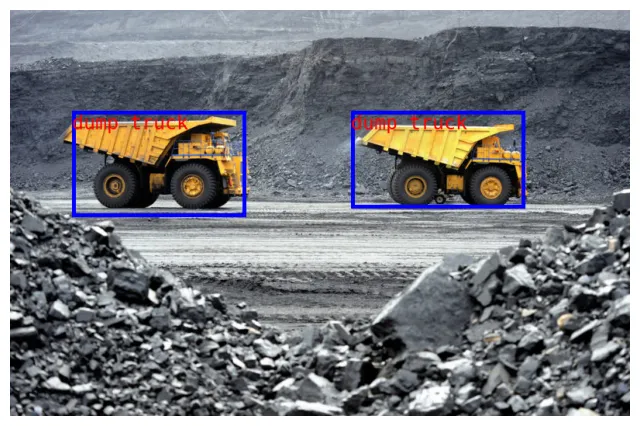使用視覺語言模型(VLMs)進行目標檢測
在過去,你必須自己訓練模型,收集訓練數據,但現在許多基礎模型允許你在它們的基礎上進行微調,以獲得一個能夠檢測目標并與用戶用自然語言互動的系統。有數百種模型和潛在應用場景,目標檢測在這些場景中非常有用,尤其是隨著小型語言模型的興起,所以今天我們將嘗試使用MLX上的Qwen2-VL-7B-Instruct-8bit。

我們將使用MLX-VLM,這是由Prince Canuma(Blaizzy)創建的一個包,他是一位熱衷于開發和移植大型語言模型以兼容MLX的熱情開發者,這個框架為我們用戶抽象了很多代碼,使我們能夠用很少的代碼行運行這些模型。現在讓我們來看下面的代碼片段。你會發現它非常簡單。首先,你可以從Hugging Face定義模型,框架將下載所有相關組件。這個過程非常簡單,因為這個庫還提供了多個實用工具(apply_chat_template),可以將OpenAI的標準提示模板轉換為小型VLMs所需的模板。

這里的一個重要注意事項是在編寫代碼時,這個庫中的系統角色出現了一些問題,但未來很可能可以添加。但在本例中,我們在一個用戶消息中傳遞任務和響應格式,基本上我們將要求模型識別所有對象并返回一個坐標列表,其中第一個頂部將是邊界框的最小x/y坐標,后者將是最大坐標。同時,我們包括了對象名稱,并要求模型以JSON對象的形式返回:
from mlx_vlm import load, apply_chat_template, generate
from mlx_vlm.utils import load_image
model, processor = load("mlx-community/Qwen2-VL-7B-Instruct-8bit")
config = model.config
image_path = "images/test.jpg"
image = load_image(image_path)
messages = [
{
"role": "user",
"content": """detect all the objects in the image, return bounding boxes for all of them using the following format: [{
"object": "object_name",
"bboxes": [[xmin, ymin, xmax, ymax], [xmin, ymin, xmax, ymax], ...]
}, ...]""",
}
]
prompt = apply_chat_template(processor, config, messages)
output = generate(model, processor, image, prompt, max_tokens=1000, temperature=0.7)
print(output)運行前面的代碼后,你將收到一個JSON響應,正確識別了兩輛卡車:
[{
"object": "dump truck",
"bboxes": [
[100, 250, 380, 510]
]
}, {
"object": "dump truck",
"bboxes": [
[550, 250, 830, 490]
]
}]鑒于我們有了對象名稱和邊界框坐標,我們可以編寫一個函數將這些結果繪制在圖像上。代碼如下:
import json
import re
import matplotlib.pyplot as plt
from PIL import Image, ImageDraw, ImageFont
def draw_and_plot_boxes_from_json(json_data, image_path):
"""
Parses the JSON data to extract bounding box coordinates,
scales them according to the image size, draws the boxes on the image,
and plots the image.
Args:
json_data (str or list): The JSON data as a string or already parsed list.
image_path (str): The path to the image file on which boxes are to be drawn.
"""
# If json_data is a string, parse it into a Python object
if isinstance(json_data, str):
# Strip leading/trailing whitespaces
json_data = json_data.strip()
# Remove code fences if present
json_data = re.sub(r"^```json\s*", "", json_data)
json_data = re.sub(r"```$", "", json_data)
json_data = json_data.strip()
try:
data = json.loads(json_data)
except json.JSONDecodeError as e:
print("Failed to parse JSON data:", e)
print("JSON data was:", repr(json_data))
return
else:
data = json_data
# Open the image
try:
img = Image.open(image_path)
except FileNotFoundError:
print(f"Image file not found at {image_path}. Please check the path.")
return
draw = ImageDraw.Draw(img)
width, height = img.size
# Change this part for Windows OS
# ImageFont.FreeTypeFont(r"C:\Windows\Fonts\CONSOLA.ttf", size=25)
font = ImageFont.truetype("/System/Library/Fonts/Menlo.ttc", size=25) # Process and draw boxes
for item in data:
object_type = item.get("object", "unknown")
for bbox in item.get("bboxes", []):
x1, y1, x2, y2 = bbox
# Scale down coordinates from a 1000x1000 grid to the actual image size
x1 = x1 * width / 1000
y1 = y1 * height / 1000
x2 = x2 * width / 1000
y2 = y2 * height / 1000
# Draw the rectangle on the image
draw.rectangle([(x1, y1), (x2, y2)], outline="blue", width=5)
text_position = (x1, y1)
draw.text(text_position, object_type, fill="red", font=font)
# Plot the image using matplotlib
plt.figure(figsize=(8, 8))
plt.imshow(img)
plt.axis("off") # Hide axes ticks
plt.show()繪制結果如下:

總結
VLMs正在快速發展。兩年前,還沒有能夠適應MacBook并表現如此出色的模型。我個人的猜測是,這些模型將繼續發展,最終達到像YOLO這樣的模型的能力。還有很長的路要走,但正如你在這篇文章中看到的,設置這個演示非常容易。在邊緣設備上開發這種應用的潛力是無限的,我相信它們將在采礦、石油和天然氣、基礎設施和監控等行業產生重大影響。最好的部分是我們甚至還沒有討論微調、RAG或提示工程,這只是模型能力的展示。











































